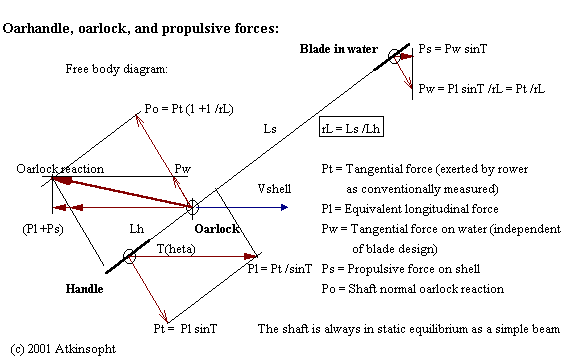 Figure 1
Figure 1
In fact, the forces (Pw and Ps) between the blade and the water depend solely upon the force (Pt) exerted by the rower on the oar handle as - geometrically modified by the oar lever ratio (rL = Lshaft /Lhandle) and the angle T thus:
Pw = Pt /rL and Ps = Pt sin(T) /rL (see Figure 1). These expressions have nothing whatever to say about blade characteristics. For a given Pt Pw would not change even had the blade the form of a floor mop; exerting Pt the same in each case produces Pw the same in each case.
 Figure 1
Figure 1
Since an oar blade has no appreciable acceleration with respect to the water - thus generating virtually no oarshaft inertial forces - the oar acts purely as a simple beam statically loaded and in equilibrium with a concentrated load Pt (1 +1/rL) at the oarlock between end reactions, Pt and Pt /rL, at the rower and water respectively. As a corollary result then: blade design, if not extreme, can have little effect on the effort applied to the handle by the rower.
Note, though, that under conditions of high oar handle speed (such as with small blade surface or drag) the feel becomes "lighter" - but only in the sense that the rower is now denied the ability to maintain an effective pull by the higher speed.
Conversely, as blade resistance to slipping increases (as with increased surface) the rower is ever more easily able to achieve his maximum handle effort. The results of V. Kleshnev of the AIS seem to indicate a general independence of peak force and stroke rate showing that within ordinary limits the rower's effort is not reduced by increased oarhandle speed.
Pw remains always and only equal to Pt /rL no matter what shape, size, or form acts upon the water.
Thus, in the end, oar blade geometric, physical, and aerodynamic characteristics affect mainly the transverse blade slip and its zero- slip locus which, together, determine the blade losses (its efficiency) and, ultimately, the advance of the shell per stroke. Blade characteristics can modify slip and zero-slip locus but have little effect on the propulsive force "exerted" upon the water.